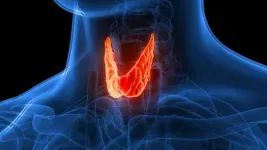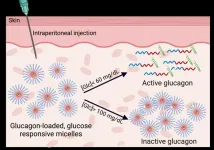(Press-News.org) Rice University is part of a multiuniversity research team that has secured an award of up to $34.9 million from the Advanced Research Projects Agency for Health (ARPA-H) to accelerate the development of a bioelectronic implant designed to improve adherence for obesity and type 2 diabetes (T2D) treatment while reducing development and manufacturing costs.
Rice University’s Biotech Launch Pad will lead the commercialization effort for “Rx On-site Generation Using Electronics” (ROGUE), a self-contained, durable implantable device that houses cells engineered to produce T2D and obesity therapies in response to patients’ physiological needs.
Carnegie Mellon University leads the team of researchers driving the accelerated development and testing of ROGUE, which functions as a “living pharmacy” designed to make biologic drugs, or biologics (a rapidly expanding group of therapies derived from living cells), accessible in the body on demand. With a target cost of goods below $1,000 for at least one year of therapy, ROGUE aims to significantly lower the costs of biologics-based treatments.
ROGUE uses closed-loop bioelectronics to support, monitor and adjust drug production and dosing as well as communicate with patients. The implant will be recharged using a wearable device weekly or even less frequently, eliminating the need for managing daily, weekly or monthly medication administering, storage and restocking. This technology is designed for rapid and cost-effective deployment via a minimally invasive procedure in an outpatient clinic.
“ROGUE’s innovative design combines efficient biological manufacturing, long-term durability and patient-friendly features that have the potential to transform the landscape of biologics delivery,” said Omid Veiseh, professor of bioengineering and faculty director of the Rice Biotech Launch Pad. “With the Rice Biotech Launch Pad leading the clinical translation and commercialization efforts, this funding will allow us to expedite the development and clinical trials of this groundbreaking technology, making it accessible to patients sooner.”
In-house entrepreneur and executive director of the Rice accelerator, Paul Wotton, will be involved in every step of the process to ensure the evolution of this technology from research to clinical translation to an independent company.
“With the Biotech Launch Pad, our goal is venture creation in parallel to the groundbreaking research at Rice and its collaborating institutions,” Wotton said.
Including backing for ROGUE, the team of researchers developing the project has received over $100 million through cooperative agreements from ARPA-H and the Defense Advanced Research Projects Agency (DARPA) for two other “living pharmacy” projects — THOR and NTRAIN.
“This level of support speaks volumes to just how transformative these innovations could be, and therefore how important it is to facilitate their translation,” Wotton said.
“I am absolutely thrilled by ARPA-H’s strong support for the Rice Biotech Launchpad’s efforts in accelerating breakthrough bioelectronic technology transition from the bench to the bedside,” said Paul Cherukuri, Rice’s vice president for innovation and chief innovation officer.
Carnegie Mellon materials science and bioengineer Tzahi Cohen-Karni said that ROGUE’s bioelectronic integration represents a revolutionary advancement in biologics production.
“Our approach enables on-demand production of therapeutics in a highly energy-efficient manner,” said Cohen-Karni, who serves as primary investigator on the ARPA-H award. “This technology not only simplifies the delivery of life-saving medications but also enhances patient comfort and adherence. ROGUE’s precision and adaptability offer a much-needed improvement in both treatment efficacy and patient experience.”
Jonathan Rivnay, a professor of biomedical engineering at Northwestern University, said that biologics, including antibodies, hormones, growth factors and cytokines, are expensive and account for a significant portion of health care expenses.
“ROGUE’s ability to produce glucagon-like peptide 1 receptor agonist (GLP-1 RA) on site will address these high costs and improve patient adherence by eliminating the need for frequent injections,” Rivnay said. “GLP-1 RAs have proven effective in enhancing insulin secretion, reducing glucose levels and promoting significant weight loss, making them a first-line therapy for diabetes and obesity.
“Our collaborative efforts are paving the way for the ROGUE platform to become a revolutionary force in the field of biologics. This technology not only addresses the limitations of current biologics but also offers a sustainable, long-term solution for managing chronic diseases.”
GLP-1 RAs are a leading class of drugs for treating patients with T2D and obesity. Unlike other T2D therapies, GLP-1 RA-based drugs are also effective against obesity. Despite their efficacy, GLP-1 RAs are expensive and often inaccessible to many patients. ROGUE’s sustainable, on-demand production system will mitigate these challenges by providing a cost-effective, widely available solution, according to the research team. The ROGUE device is expected to offer the same benefits as traditional GLP-1 RAs, including the prevention of cardiovascular and kidney disease progression in high-risk patients.
This pioneering project was rigorously assessed as a potential project for ARPA-H, a federal funding agency established in 2022 to support research that has “the potential to transform entire areas of medicine and health.” This effort is funded under ARPA-H’s REACT program and includes funding for a first-in-human clinical trial for patients facing obesity and T2D. The trial preparation is slated to begin in the fifth year of the six-year project.
Other Rice co-principal investigators include Jacob Robinson, a professor of electrical and computer engineering and bioengineering who leads integration efforts for the project in line with the focus on clinical translation and commercialization; and Oleg Igoshin, a professor of bioengineering and chemistry and associate chair of the bioengineering department who oversees pharmacokinetics and pharmacodynamics modeling.
ROGUE is a collaboration between multiple institutions, including Rice, Carnegie Mellon, Northwestern, Boston University, Georgia Institute of Technology, University of California Berkeley, the Mayo Clinic and New York City-based Bruder Consulting and Venture Group. The consortium brings together experts in biomedical engineering, synthetic biology, materials science, electrical engineering and related fields to co-design and develop the implant technology.
Download associated media assets:
https://rice.box.com/s/qc0a3wq29oyw9wobiipwnz1rxrirlo5m
About the Rice Biotech Launch Pad
The Rice Biotech Launch Pad is a Houston-based accelerator focused on expediting the translation of Rice University’s health and medical technology discoveries into cures. This initiative is designed to help advance internally discovered platform technologies from concept to clinical studies and commercialization. The Rice Biotech Launch Pad will identify and support highly differentiated projects while driving the expansion of Houston as a world-class medical innovation ecosystem. The accelerator will bring together local researchers with a network of industry executives. For more information, please visit https://biotechlaunchpad.rice.edu/ .
About Rice University
Located on a 300-acre forested campus in Houston, Rice University is consistently ranked among the nation’s top 20 universities by U.S. News & World Report. Rice has highly respected schools of architecture, business, continuing studies, engineering, humanities, music, natural sciences and social sciences and is home to the Baker Institute for Public Policy. With 4,574 undergraduates and 3,982 graduate students, Rice’s undergraduate student-to-faculty ratio is just under 6-to-1. Its residential college system builds close-knit communities and lifelong friendships, just one reason why Rice is ranked No. 1 for lots of race/class interaction, No. 2 for best-run colleges and No. 12 for quality of life by the Princeton Review. Rice is also rated as a best value among private universities by Kiplinger’s Personal Finance.
END
Rice’s Biotech Launch Pad to lead commercialization of bioelectrical implant treatment for obesity, type 2 diabetes
$34.9M ARPA-H project aims to disrupt therapies’ market and radically improve treatment options
2024-10-02
ELSE PRESS RELEASES FROM THIS DATE:
Carnegie Mellon to lead development of implantable cell-based bioelectronic devices for patient-specific treatment and disease monitoring
2024-10-02
PITTSBURGH – A Carnegie Mellon University-led team has secured an award of up to $42 million from the Advanced Research Projects Agency for Health (ARPA-H) to accelerate the development of implantable, cell-based bioelectronic devices that deliver patient-specific therapy and monitor disease status, for conditions like hypo- and hyperthyroidism, in real time. This award is part of the ARPA-H REACT program, which supports the advancement of implantable bioelectronic devices to improve patient management of chronic diseases.
Burak ...
Case Western Reserve, Vanderbilt universities to develop incisionless prostate surgery using MRI and robotics
2024-10-02
CLEVELAND—Researchers at Case Western Reserve University and Vanderbilt University are pioneering a new approach to prostate cancer surgery by combining advanced robotics and “low-field” MRI technology.
The research aims to allow highly accurate, patient-tailored prostate cancer surgeries without the need for traditional incisions. This innovative research marks a major step in developing minimally invasive treatments for prostate cancer, with the potential to improve both safety and efficiency for patients.
The project is being funded by a new five-year, $3.7 million grant from the National Cancer Institute, part of the ...
Carnegie Mellon University secures ARPA-H award to improve adherence, lower cost of treatment for obesity and Type 2 diabetes patients
2024-10-02
PITTSBURGH – A Carnegie Mellon University-led team of researchers has secured an award of up to $34.9 million from the Advanced Research Projects Agency for Health (ARPA-H). The funds will fast track a bioelectronic implant that could radically improve treatment options and significantly reduce the cost of care for patients with obesity and Type 2 diabetes.
The award will drive the accelerated development and testing of “Rx On-site Generation Using Electronics (ROGUE),” a bioelectrical device that hosts a “living pharmacy,” consisting of engineered cells that produce biological therapy to treat Type 2 diabetes and obesity. The device will offer continuous, ...
A new injectable to prevent and treat hypoglycemia
2024-10-02
People with diabetes take insulin to lower high blood sugar. However, if glucose levels plunge too low — from taking too much insulin or not eating enough sugar — people can experience hypoglycemia, which can lead to dizziness, cognitive impairment, seizures or comas. To prevent and treat this condition, researchers in ACS Central Science report encapsulating the hormone glucagon. In mouse trials, the nanocapsules activated when blood sugar levels dropped dangerously low and quickly restored glucose levels.
Glucagon is a hormone that signals the liver to ...
Turning plants into workout supplement bio-factories
2024-10-02
It’s important to eat your veggies, but some essential vitamins and nutrients can only be found in animals, including certain amino acids and peptides. But, in a proof-of-concept study published in ACS’ Journal of Agricultural and Food Chemistry, researchers developed a method to produce creatine, carnosine and taurine — all animal-based nutrients and common workout supplements — right inside a plant. The system allows for different synthetic modules to be easily stacked together to boost production.
Plants can be surprisingly receptive when asked to produce compounds ...
Pablo Manavella appointed next Editor-In-Chief of The Plant Cell
2024-10-02
The American Society of Plant Biologists (ASPB) is excited to announce Pablo Manavella will serve as the next Editor-in-Chief of The Plant Cell. The Plant Cell is a leading international society journal that publishes novel research of special significance in plant biology, especially in the areas of cellular biology, molecular biology, biochemistry, genetics, development, and evolution.
Manavella is currently a Consejo Superior de Investigaciones Científicas (CSIC) researcher at the Institute for Mediterranean and Subtropical Horticulture (IHSM) in Málaga, Spain. He is the Principal Investigator in a lab focusing on the intricate mechanisms regulating ...
Unveiling genetic insights: how PAI-1 polymorphisms influence COVID-19 outcomes
2024-10-02
Despite global vaccination efforts, COVID-19 continues to pose significant risks, leading to severe complications and fatalities. These risks are driven by disrupted coagulation, impaired fibrinolysis, which is the process of breaking blood clots, and heightened inflammatory responses. The fibrinolytic system, crucial for maintaining balance within the coagulation cascade, relies on plasmin-mediated fibrin degradation. Plasminogen activators convert plasminogen into plasmin, an enzyme that breaks down ...
Redefining Publishing: PLOS receives multi-million-dollar grant funding for new research initiative
2024-10-02
SAN FRANCISCO —PLOS today announced that it has received a $1.5 million grant from the Robert Wood Johnson Foundation and a $1 million grant from the Gordon and Betty Moore Foundation to support our mission to drive Open Science forward with meaningful change in scholarly publishing. The funds enable PLOS to embark on an ambitious 18-month research and design project to explore how to tackle two barriers that exclude many researchers from meaningfully participating in Open Science: affordability ...
Planning a drug’s route in the body with synthetic chemistry
2024-10-02
Researchers at the RIKEN Cluster for Pioneering Research (CPR) have developed technology that can alter, within the body, the recognized identity of proteins. The innovation, published in Nature Communications on October 2, allowed researchers to target mouse tumors with a protein and then transport that protein out of the body. This means that cancer-killing drugs could be sent directly to tumors and then excreted from the body after dropping off their payload. The technology also has the potential to allow multi-purpose drugs that can travel from organ to organ, performing ...
Smoke from megafires puts orchard trees at risk
2024-10-02
Smoke From Megafires Puts Orchard Trees at Risk
Effects Last Months, Reducing Nut Crop Yields
By Amy Quinton | October 2, 2023
Long-term smoke exposure from massive wildfires lowers the energy reserves of orchard trees and can cut their nut production by half, researchers at the University of California, Davis, found. The smoke can affect trees for months after a megafire, depressing their bloom and the next season’s harvest. This finding reveals a new danger from wildfires that could affect plant health in both agricultural and natural environments.
Nature Plants published ...
LAST 30 PRESS RELEASES:
New expert guidance urges caution before surgery for patients with treatment-resistant constipation
Solar hydrogen can now be produced efficiently without the scarce metal platinum
Sleeping in on weekends may help boost teens’ mental health
Study: Teens use cellphones for an hour a day at school
After more than two years of war, Palestinian children are hungry, denied education and “like the living dead”
The untold story of life with Prader-Willi syndrome - according to the siblings who live it
How the parasite that ‘gave up sex’ found more hosts – and why its victory won’t last
When is it time to jump? The boiling frog problem of AI use in physics education
Twitter data reveals partisan divide in understanding why pollen season's getting worse
AI is quick but risky for updating old software
Revolutionizing biosecurity: new multi-omics framework to transform invasive species management
From ancient herb to modern medicine: new review unveils the multi-targeted healing potential of Borago officinalis
Building a global scientific community: Biological Diversity Journal announces dual recruitment of Editorial Board and Youth Editorial Board members
Microbes that break down antibiotics help protect ecosystems under drug pollution
Smart biochar that remembers pollutants offers a new way to clean water and recycle biomass
Rice genes matter more than domestication in shaping plant microbiomes
Ticking time bomb: Some farmers report as many as 70 tick encounters over a 6-month period
Turning garden and crop waste into plastics
Scientists discover ‘platypus galaxies’ in the early universe
Seeing thyroid cancer in a new light: when AI meets label-free imaging in the operating room
Neutrophil-to-lymphocyte ratio may aid risk stratification in depressive disorder
2026 Seismological Society of America Annual Meeting
AI-powered ECG analysis offers promising path for early detection of chronic obstructive pulmonary disease, says Mount Sinai researchers
GIMM uncovers flaws in lab-grown heart cells and paves the way for improved treatments
Cracking the evolutionary code of sleep
Medications could help the aging brain cope with surgery, memory impairment
Back pain linked to worse sleep years later in men over 65, according to study
CDC urges ‘shared decision-making’ on some childhood vaccines; many unclear about what that means
New research finds that an ‘equal treatment’ approach to economic opportunity advertising can backfire
Researchers create shape-shifting, self-navigating microparticles
[Press-News.org] Rice’s Biotech Launch Pad to lead commercialization of bioelectrical implant treatment for obesity, type 2 diabetes$34.9M ARPA-H project aims to disrupt therapies’ market and radically improve treatment options








